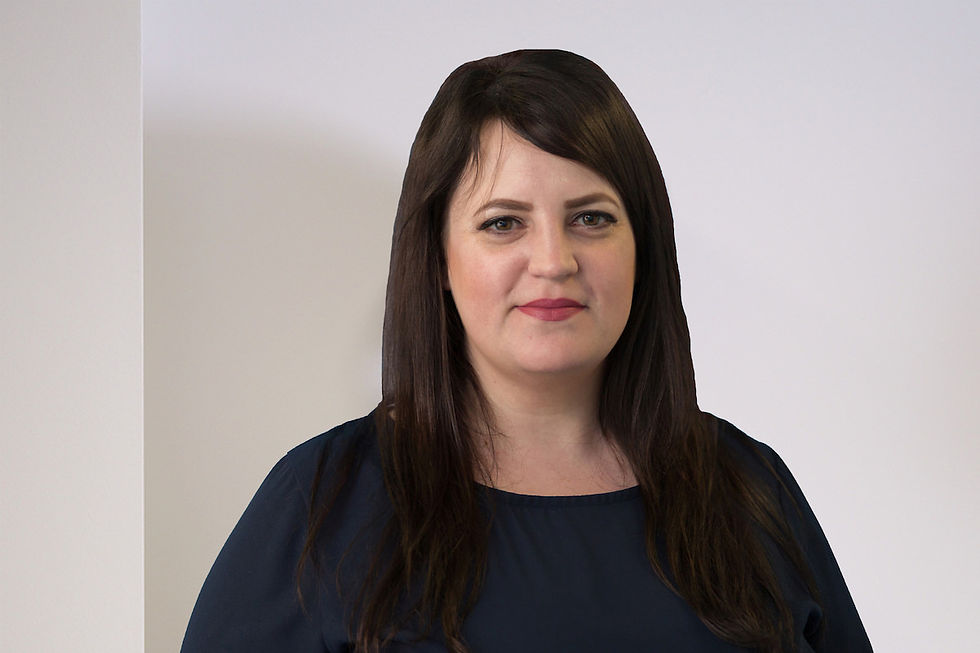Meet our acoustics expert
- shungate6
- Nov 1, 2023
- 7 min read
Updated: Feb 6, 2024

Interview with Acoustician Ros Lambert- Porter
Tell us about yourself, your profession and expertise.
I am Ros Lambert-Porter, and I head up our acoustics business at Hawkins, a multidisciplinary engineering consultancy and expert witness service provider. I am an engineering consultant in the field of acoustics, noise and vibration and have practiced as a consultant acoustics engineer for 17 years. My areas of expertise are building acoustics design, noise and vibration exposure, and noise and wellbeing at work. I have worked in Africa, Australia and the UK and consulted on projects from acoustic pod design through to vibration assessment on large salt mines. I am also an expert witness, providing evidence in court on acoustics-related matters.
How did you come to be an acoustician? Tell us about your experience.
I was born into a family of musicians and have always had a keen interest in sound and how it alters the way people feel, whether it be in response to a noisy neighbour, or in response to an opera. I studied music for a long time before deciding to read Audiology (hearing science) at University, only to then move onto studying Applied Science and Applied Acoustics. Because of this varied academic experience, my approach to acoustic problems tends to be centred on the human experience of acoustics, rather than the engineering alone.
What are your most career defining projects?
One of the first projects I consulted for was a lecture theatre at a university in the Western Cape. The theatre was very large but we wanted the lecturer to be able to speak and be heard without amplification. While modelling software was available, we approached the design of the theatre from ‘first principles’ and I had to manually draw the sound paths (rays) on the drawings by hand. I have worked on similar projects since that time, but none quite as aesthetically or as a learning experience.
On another case, I successfully assisted a man who had been catastrophically injured at work. Through my analysis, I was able to demonstrate to the Court that he could not have heard a warning alarm when he was injured. I found this particularly rewarding to be able to assist with something that really mattered to an individual and put an end to dangerous working practices.
What is the importance of acoustics in the workplace?
I consider acoustics to be one of the most important factors in influencing the wellbeing and productivity of staff. There is research to support my views, but one need only consider the way people worked during lockdown to understand why it is important. Many people have reported moving to a different room to get away from a noisy partner, putting on the radio so they did not feel so isolated, or preferring a quiet workspace to complete tasks requiring a great deal of concentration. Just as light and design can indicate to us the type of work a space is designed for, so can the acoustic performance of that space.
Consideration of the different soundscapes that can be created in a work environment is especially important to neurodivergent staff, many of whom find it difficult to tolerate poor acoustics for very long. Guidance on the required acoustic performance of learning environments has been available for a very long time. However, we have only just started to consider how those learners, as adults, might continue to be supported at the workplace through good acoustic design.
Given our increasing reliance on video conferencing, it is also important to consider how that impacts on the requirements of meeting rooms. A face to face meeting does not necessarily require the tight control on reverberation (room echo) as a video conferencing set-up. Add to that the fact that many people use video conferencing facilities at much higher volumes (loudness) than typical human speech, and there is a tendency to raise one’s voice when using those facilities. All of this can have a significant impact on the privacy of the room as the room construction must control higher levels of noise. Technology and working practices are constantly changing, and so too are the acoustic requirements expected of workplaces for optimal comfort. Acoustics engineers must constantly adapt to those requirements.
What are the common acoustic issues in the workplace?
Poor space planning has a significant impact on whether or not staff will be distracted by noise in an office. I am frequently asked to assess acoustic problems in offices where a simple rearrangement of the furniture could solve the issue. Training staff on how to use the office goes a long way. For example, we are often asked what should be done when disruption occurs from individuals taking Teams calls at their desks. The answer is a simple one – create a space in which it is appropriate to take Teams calls, which is separate to any areas in which others must concentrate. Poor attention to construction detailing can also cause problems when it comes to acoustic privacy and those problems can be very difficult to rectify. Sound will travel through the smallest gaps and detailing is important. Finally, I am increasingly concerned about the misleading information provided to designers regarding the acoustic performance of various products in the market. Simply reading the data sheet of a product is not always sufficient to understand its limitations.
Are there any misconceptions about acoustic products in the commercial market? How can a designer compare performance of one product against another?
It’s not uncommon to see the literature for acoustic products claiming that a product performs to Class A (a high level of acoustic absorption) when it can only achieve Class A if it is installed in a very specific way. I also frequently see the words ‘up to’ used when referring to the performance. Again, it’s important to understand that this performance level can only be achieved under specific circumstances and will not be met as standard. The designer should never be afraid to ask for the test report of any product claiming a particular acoustic performance. You might need to sign an NDA if the report is commercially sensitive. Those reports can be difficult to read but the key is to make sure that the way in which the product is tested matches the way in which you would like to install it. For example, if you would like to include a folding wall in your design, ensure that the folding wall is tested with its seals and telescopic panel in place, rather than as a single panel. Look at the photos in the test report to ensure that it matches the product you are specifying and does not include additional features or panels that might influence its performance. Importantly, communicate with your project acoustician as early in the design process as possible and ask their opinion. We are sometimes only aware that the incorrect product has been specified once we arrive on site to carry out testing.
What should designers and project managers look out for on building site visits before design has commenced?
There are so many factors that influence performance. However, I suggest starting by visualising where your separating walls will be built. Look at the junctions between those walls and other structures. For example, if you are going to abut a partition wall to a mullion, knock on the mullion to determine how lightweight or hollow it is. Try to visualise how, once you have constructed a wall, air might still pass from one room to another. If you wish to expose the structural soffit, plan in advance any acoustic treatment that aligns with your aesthetic. Don’t forget that sound travels in all directions, including through the floor and ceiling. If at all possible, take your acoustician with you to walk through the site and comment on potential issues. We can often spot them immediately. This can save several thousands of pounds later on.
Tell us how you work with GTA Interior.
This is largely dependent on the project, but we normally begin by discussing what the client wants to achieve. If, for example, the client wants to create a recording studio in the middle of a noisy office, we would support GTA in a meeting with the client to define the problems that could be faced and what they can expect in terms of both cost and performance. Once the brief and employer’s requirements have been defined, we then produce a report based on GTA’s design. Acoustics reports are not always simple to understand so we consider it vital to follow up our reports with a meeting where we run through our recommendations with GTA and discuss how they might impact the design.
Working closely with the team is so important to ensure that, not only are any potential difficulties communicated, but also to assist the designer to select materials that achieve our required performance and also align with the aesthetic design. We get involved during the construction phase too, to check any tricky details and, importantly, to work with the builders on site to assist them in achieving them. Finally, we test the spaces. I have seen many commissioning reports that include only the results and no recommendations for improvement. If, for any reason, a space does not perform as expected, we detail the reasons and work with GTA to come up with a solution.
Tell us about GTA projects you have collaborated with us on.
I have worked with GTA on two projects for PA Consulting – one in London and one in Cambridge. Both had their unique challenges, however, the base build at the Cambridge office was particularly tricky, with different soffit constructions, profiled decks in some areas and high levels of privacy requirements. A feature of the fitout was an oval glass meeting room for which a special ceiling was designed in order to assist with the acoustic performance.

A particularly enjoyable project was the conversion of a store room and a prayer room in the basement of the Channel 4 building into high performance editing suites and the refurbishment of their existing studios. The store room conversion was particularly challenging as the existing walls were to remain in place and could only be modified.

We recently assisted GTA with the design of several specialist spaces within an office fit-out, including a learning academy, a speakeasy bar and a town hall presentation space. Each of those spaces brought with it its own acoustic challenges, but we are particularly proud to have achieved good acoustic performance within the speakeasy bar without compromising the aesthetic design of the space.
We are currently working on a large development in Brighton in which three buildings are to be fit-out to a combination of Cat A, Cat A+ and Cat B spaces. Both BREEAM ‘Excellent’ and WELL ‘Platinum’ have been targeted for the development, which can be very difficult to achieve. We paid particular attention to a gym in the basement and carried out tests to ensure that the noise resulting from weight impacts and machines would be acceptable in the spaces above.
Each of these projects has involved an element of acoustic design that has been difficult to achieve or has required a lot of thought. In each case we have worked with GTA to achieve our targets. This collaboration involves the full team delivering the project, from the project manager and designer through to the construction team.
Get in touch today to discuss your project with an expert at GTA.







